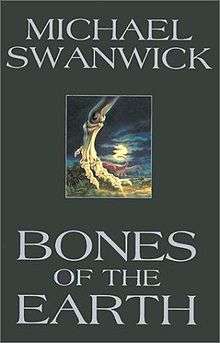Bones of the Earth
 Cover of first edition (hardcover) | |
| Author | Michael Swanwick |
|---|---|
| Cover artist | Joe DeVito |
| Country | United States |
| Language | English |
| Genre | Science fiction, Paleontology novel |
| Publisher | Eos (HarperCollins) |
Publication date | 2002 |
| Media type | Print (hardback & paperback) |
| Pages | 335 pages (1st edition) |
| ISBN | 0-380-97836-9 (1st edition) |
| OCLC | 47056437 |
| 813/.54 21 | |
| LC Class | PS3569.W28 B66 2002 |
Bones of the Earth is a 2002 science fiction novel by Michael Swanwick. It was nominated for the Nebula Award for Best Novel in 2002, and the Hugo,[1] Campbell, and Locus Awards in 2003.[2]
Plot introduction
Expanded from his Hugo Award-winning story "Scherzo with Tyrannosaur", Bones of the Earth spans geologic time, not just centuries but millennia, from the pre-historic past to the distant and unknown future. Most of the novel's events take place in the age of the dinosaurs. The "bones" of the title refer to the time traveling team players described in the story that study throughout Earth's history and pre-history.
Plot summary
Paleontologist Richard Leyster has reached the pinnacle of his profession: a position with the Smithsonian Museum plus a groundbreaking dinosaur fossil site he can research, publish on, and learn from for years to come. There is nothing that could lure him away - until a disturbingly secretive stranger named Harry Griffin enters Leyster's office with an ice cooler and a job offer.
In the cooler is the head of a freshly killed stegosaurus. Griffin has been entrusted with an extraordinary gift; an impossible technology on loan to humanity for an undisclosed purpose from beings known to a select few as the Unchanging. The only stipulation being is not to alter recorded history. If the taboo is broken, the contract becomes null and void.
Time travel has become a reality millions of years before it rationally could be. With it, Richard Leyster and his colleagues make their most cherished fantasies come true. They study dinosaurs up close, in their own time and environment. Also, individual lives have the freedom to turn back on themselves. People meet, shake hands, and converse with their younger or older versions at various crossroads in time. One wrong word, a single misguided act, could be disastrous to the project and to the world. Griffin's job is to make sure everything that is supposed to happen does happen, no matter who is destined to be hurt... or die.
And then there's Dr. Gertrude Salley - passionate, fearless, and brutally ambitious - a genius rebel in the tight community of "bone men" and women. Alternately, both Leyster's and Griffin's chief rival, trusted colleague, despised nemesis, and inscrutable lover at various junctures throughout time, Salley is relentlessly driven to tamper with the working mechanisms of natural law, audaciously trespassing in forbidden areas, pushing paradox to the edge no matter what the consequences may be. And, when they concern the largest, most savage creatures that ever lived, the consequences become terrifying indeed, resulting in a team of "bone men" becoming stranded for two years in the Mesozoic Era.
Apart from failed attempts to rescue the team from the past, slowly, something begins to happen. The temporal mechanics are altered in such a way that two time streams emerge. The first focuses on the struggling team in the Mesozoic's Maastrichtian Age, some 65 millions years ago. In the far future, in what will be known as the Telezoic Era, a younger version of Gertrude Salley meets an older version of herself - the one who was responsible for the split in the timeline - now happily living in the center of the new supercontinent of Ultima Pangea. There, they also finally meet the mysterious benefactors known as the Unchanging, who are actually an evolved avian species that inherited the Earth upon the extinction of the human race.
Preparing to beg the Unchanging not to shut down the whole enterprise of time travel and the sciences based upon it, Gertrude also discovers their apparent fascination with humanity and that their gift of time travel was simply a means to study the human race in their own right. She also realizes the difficulty in the ability of the incomprehensible far-future species to forgive, for incomprehensible reasons, the creation of a deeply dangerous timeline anomaly back in the 21st century. However, interestingly, the team trapped in the Maastrichtian Age makes a remarkable discovery.
One of the team members arrives at a genuinely unique explanation for the Cretaceous–Paleogene extinction event. They had already determined that predator dinosaurs farm and ranch their prey, singing infrasound commands that lead their ultimate prey to green pastures. One of the team speculated that dinosaur migration might be similarly controlled by the song of the Earth, the song of tectonic plates shifting in the crust of the planet. And the possibility of the Chicxulub meteor having been so great as to detune the song of the Earth for a decade or a century, deafening the dinosaurs so they could not migrate, causing them to starve.
In the end, the Unchanging decide to retroactively remove the time travel science from human hands, thereby rendering all of the events up to that point irrelevant. But, out of the ashes of this paradox, its tangles and attenuations mercifully forgotten, a love of the world is retained - a deep unselfish love of learning the world and all its creatures.
References
- ↑ "2002 Award Winners & Nominees". Worlds Without End. Retrieved 2009-08-05.
- ↑ "2003 Award Winners & Nominees". Worlds Without End. Retrieved 2009-08-05.
External links
- Bones of the Earth at Worlds Without End